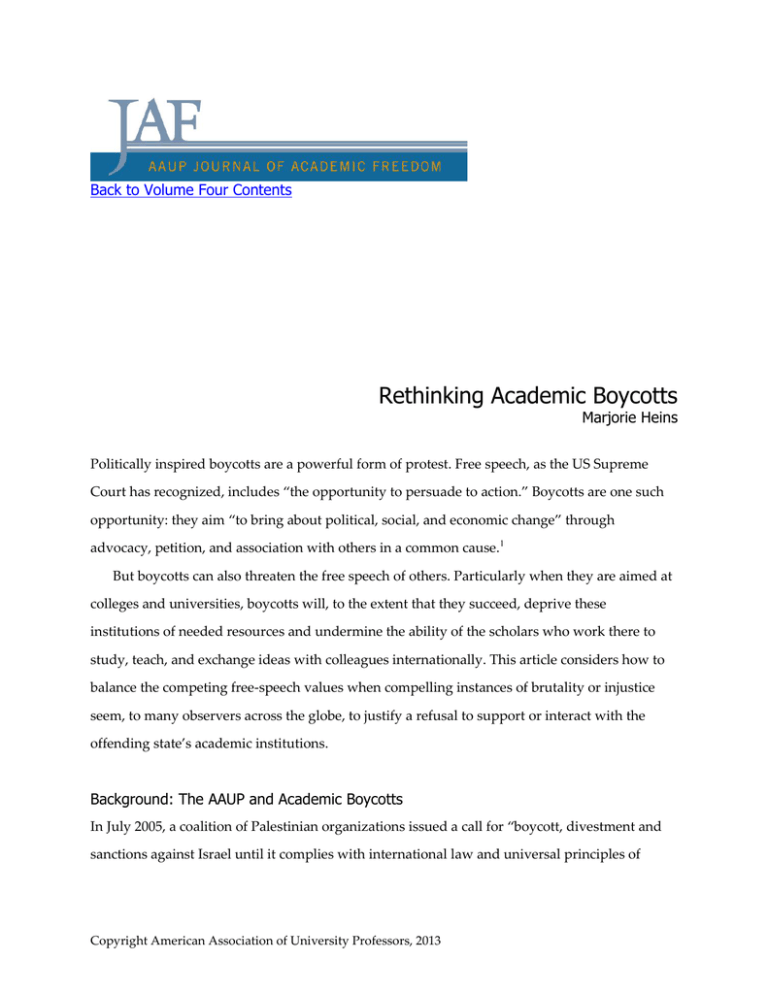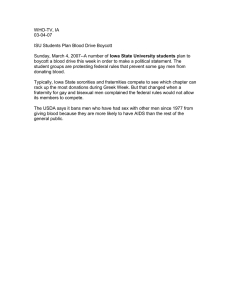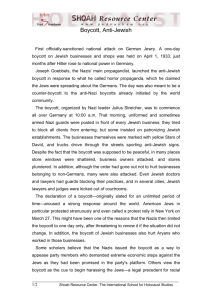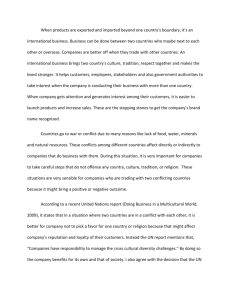Rethinking Academic Boycotts Back to Volume Four Contents Marjorie Heins
advertisement

Back to Volume Four Contents Rethinking Academic Boycotts Marjorie Heins Politically inspired boycotts are a powerful form of protest. Free speech, as the US Supreme Court has recognized, includes “the opportunity to persuade to action.” Boycotts are one such opportunity: they aim “to bring about political, social, and economic change” through advocacy, petition, and association with others in a common cause.1 But boycotts can also threaten the free speech of others. Particularly when they are aimed at colleges and universities, boycotts will, to the extent that they succeed, deprive these institutions of needed resources and undermine the ability of the scholars who work there to study, teach, and exchange ideas with colleagues internationally. This article considers how to balance the competing free-speech values when compelling instances of brutality or injustice seem, to many observers across the globe, to justify a refusal to support or interact with the offending state’s academic institutions. Background: The AAUP and Academic Boycotts In July 2005, a coalition of Palestinian organizations issued a call for “boycott, divestment and sanctions against Israel until it complies with international law and universal principles of Copyright American Association of University Professors, 2013 AAUP Journal of Academic Freedom Volume Four human rights.” In its statement, the coalition cited an advisory opinion of the International Court of Justice, which found that the wall that Israel had built on occupied Palestinian territory was illegal. The statement added that thirty-seven years into the occupation, “Israel continues to expand Jewish colonies,” and fifty-seven years after Israel “was built mainly on land ethnically cleansed of its Palestinian owners, a majority of Palestinians are refugees, most of whom are stateless.” The statement drew analogies to the international community’s “struggle to abolish apartheid in South Africa through diverse forms of boycott, divestment and sanctions.”2 One of the many groups that sponsored the call was the Palestinian Campaign for the Academic and Cultural Boycott of Israel (PACBI). In 2004, PACBI had called for a boycott of “all Israeli academic and cultural institutions until Israel withdraws from all the lands occupied in 1967, including East Jerusalem; removes all its colonies in those lands; agrees to United Nations resolutions relevant to the restitution of Palestinian refugees’ rights; and dismantles its system of apartheid.” PACBI’s rationale was that “Israeli academic institutions (mostly state controlled) and the vast majority of Israeli intellectuals and academics have either contributed directly to the Israeli occupation and apartheid or at the very least have been complicit through their silence.” Nevertheless, PACBI said, it was targeting institutions, not individuals, and thus hoped to “steer . . . clearly away from political tests or other McCarthyist measures.”3 Responding to the PACBI call, the British Association of University Teachers (AUT) in 2005 announced a boycott of Bar-Ilan University and Haifa University. The reason for singling out these institutions, as a BBC news report summarized, was that Bar-Ilan ran courses in the occupied West Bank, while Haifa allegedly mistreated a professor because he had defended a graduate student’s “research into controversial areas of Israeli history.”4 The AAUP was one among many organizations that condemned the AUT announcement as a threat to academic freedom.5 Within a month, the AUT reversed itself,6 but in view of the continuing controversy, the AAUP’s Committee A felt a broader exploration of the principles at stake was needed. A planned conference on the issue in Bellagio, Italy, was cancelled after four Israeli scholars refused to participate, in part because they objected to the fact that boycott 2 3 Rethinking Academic Boycotts Marjorie Heins proponents had been invited to attend.7 Ultimately, Committee A published a report, “On Academic Boycotts,” in Academe, along with essays by those who would have participated in the conference, arguing both sides of the issue, and various positions in between.8 The Committee A report began by acknowledging that the AAUP’s “own complex history includes support for campus strikes, support for divestiture during the antiapartheid campaigns in South Africa, and a questioning of the requirement of institutional neutrality during the Vietnam War.” During the “intense debate” over Vietnam, for example, those urging that universities take an antiwar position argued that “‘perilous situations’ call . . . for extraordinary action.” In 1985, the AAUP called on colleges and universities “as investors to oppose apartheid” in South Africa and “urged similar action on the part of public and private pension funds serving higher education faculty.”9 But Committee A reiterated the AAUP’s opposition to academic boycotts. Unlike general economic boycotts, it said, which may indirectly affect academia but are “not meant to impair the ability of scholars to write, teach, and pursue research,” academic boycotts “strike directly at the free exchange of ideas even as they are aimed at university administrations or, in the case of the AUT call for a boycott of Israeli universities, political parties in power. The form that noncooperation with an academic institution takes inevitably involves a refusal to engage in academic discourse with teachers and researchers, not all of whom are complicit in the policies that are being protested.” The report concluded that “if boycotts are to be used at all, economic boycotts seem a preferable choice, both tactically and as a matter of principle.”10 Several contributors to the Academe symposium took issue with the AAUP’s position. Omar Barghouti, a Palestinian researcher, argued that “by turning the free flow of ideas into an absolute, unconditional value,” the AAUP was ignoring its own founding document, the 1915 Declaration of Principles, which conditioned academic freedom on “‘correlative obligations’ to further the ‘integrity’ and ‘progress’ of scientific inquiry.” He argued that discouraging bigotry and hate was one such obligation; hence the rightness of the AAUP’s “laudable call for divestment” from South Africa during apartheid. In the case of Israel, he said, PACBI targeted AAUP Journal of Academic Freedom Volume Four academic institutions “because of their complicity in perpetuating Israel’s occupation, racial discrimination, and denial of refugee rights.”11 South African contributors to the Academe issue pointed out that in fact there had been an academic boycott of South Africa, in addition to the overall campaign for divestment from the apartheid regime. Jonathan Hyslop of the University of the Witswatersrand wrote that if, as the AAUP report claimed, “antiapartheid American scholars were pursuing a divestment campaign rather than an academic boycott, they never succeeded in conveying this fine distinction to South African colleagues at the time. It certainly appeared to us, from our experience, that American universities, scholars, and journals were boycotting South African universities. . . . For practical purposes, there was an American academic boycott of South Africa in the 1980s.”12 On balance, however, Hyslop thought the boycott of South African universities was a mistake; among other things, scholars around the world “who wanted to support the explosion of critical scholarship, cultural production, and activism that the revolutionary times had produced on South African campuses” could not do so “if they were required to observe a blanket academic boycott.” The African National Congress itself began to understand “that the political developments on South African campuses were worth encouraging and that international links might contribute to this.”13 Boycotts as Free Speech The US Supreme Court definitively established First Amendment protection for politically inspired boycotts in a 1982 decision involving the battle waged by the National Association for the Advancement of Colored People (NAACP) against the remnants of Jim Crow racism in the 1960s. NAACP leaders had organized a boycott of merchants in Claiborne County, Mississippi, who refused to comply with a list of demands designed to remedy past discrimination. Three years later, seventeen of the merchants sued the NAACP, another civil rights organization, and 146 individuals who had led or participated in the boycott, using a variety of legal theories, including “malicious interference” with their businesses. A Mississippi court found 130 of the 4 5 Rethinking Academic Boycotts Marjorie Heins defendants “jointly and severally” liable for $1,250,699 in damages, plus interest and court costs. The state supreme court reversed the judgment in part, rejecting two of the legal theories, but it upheld the award of damages because, even though the years-long boycott was largely peaceful, there had been some acts of violence and intimidation, and some threats directed at African American residents in order to enforce the boycott.14 In NAACP v. Claiborne Hardware (1982), the US Supreme Court reversed the judgment. Justice John Paul Stevens’s opinion for the Court made two basic points. First, the meetings and speeches calling for the boycott, and the subsequent picketing, were free-speech activities protected by the First Amendment. The defendants “withheld their patronage from the white establishment of Claiborne County to challenge a political and economic system that had denied them the basic rights of dignity and equality that this country had fought a Civil War to secure.”15 Second was the First Amendment right to freedom of association. The defendants had “banded together and collectively expressed their dissatisfaction with a social structure that had denied them rights to equal treatment and respect.” This “practice of persons sharing common views banding together to achieve a common end is deeply embedded in the American political process.” Freedom of association is thus essential in “‘guaranteeing the right of people to make their voices heard on public issues. . . . Effective advocacy of both public and private points of view, particularly controversial ones, is undeniably enhanced by group association.’” And “while the State legitimately may impose damages for the consequences of violent conduct, it may not award compensation for the consequences of nonviolent, protected activity”—that is, it cannot make all of the leaders and participants liable for the scattered unlawful actions of a few.16 The Supreme Court made clear that picketing, leafleting, and urging boycotts are important elements of political struggle—of people peaceably seeking “to bring about political, social, and economic change.”17 Although there are limits to every constitutional right, and hence some forms of economic coercion can be regulated, there was no need in the Claiborne Hardware case AAUP Journal of Academic Freedom Volume Four to decide when a law “designed to prohibit certain forms of anticompetitive conduct or certain types of secondary pressure may restrict protected First Amendment activity.”18 In general, then (as a federal judge had put it in the context of another politically inspired boycott), “the right to petition is of such importance that it is not an improper interference [with one’s business] even when exercised by way of a boycott.”19 In its 2006 report, the AAUP’s Committee A recognized these free-speech principles when it described boycotts as “tactical weapons in political struggles.” Sports boycotts, for example— excluding from international competitions teams representing nations “whose policies members of the international community consider abhorrent”—can have a powerful symbolic effect. Cultural boycotts are similar, even though “they can affect the earning capacity of artists and writers who are banned from international events.” And academic boycotts, although they too “certainly have material effects, are usually undertaken as symbolic protests.”20 Boycotts and the Countervailing Value of Academic Freedom The fact that politically inspired boycotts—including academic boycotts—are protected by the First Amendment does not mean they are necessarily a good idea. Particularly when boycotts are aimed at free-speech activity—the resources needed for professors to teach, research, and write, as well as their ability to publish, attend international conferences, and be invited as visitors or lecturers on campuses abroad—the predictable effect is to shrink academic freedom both at the targeted institutions and throughout the world. The impact is much the same, of course, if a general boycott or divestment campaign is effective, but the intent and the message are quite different. And since so much of a boycott or divestment campaign is about the message, this distinction is important. In 1991, for example, some feminists urged a boycott of Knopf and Vintage, the publishers of Brett Easton Ellis’s American Psycho, because of the novel’s lurid descriptions of misogynist violence. In an article titled “Why Boycotting Booksellers Is a Bad Idea,” I wrote then, “The goal of boycotting a bookseller is to suppress, or censor, some literature, because of its offensive 6 7 Rethinking Academic Boycotts Marjorie Heins content, or its poor taste, or both.” And although there is a free-speech right to boycott, there is a countervailing interest in not being boycotted on account of one’s speech. Moreover, no matter how offensive American Psycho or any other individual work, “it will be the publishers, not the boycotters, who apply the litmus test. And because there are many other pressure groups in society that wish to impose very different ideological tests, the likely result will be that publishers and booksellers develop censorship apparatus with no clear standards except an inclination to avoid anything controversial.”21 This same problem of who is applying the litmus test emerged in the context of PACBI’s call for a boycott of Israeli universities. PACBI’s guidelines provide “that all Israeli academic institutions, unless proven otherwise, are complicit in maintaining the Israeli occupation and denial of basic Palestinian rights. . . . Accordingly, these institutions, all their activities, and all the events they sponsor or support must be boycotted. Events and projects involving individuals explicitly representing these complicit institutions should be boycotted, by the same token. Mere institutional affiliation to the Israeli academy is therefore not a sufficient condition for applying the boycott.”22 It is unclear, under these guidelines, what would constitute proof that an institution is not “complicit in maintaining” the occupation and denying Palestinian rights, or who would decide. Similarly, PACBI does not say who would decide that an individual professor is exempt from the boycott because she or he does not “explicitly represent” a “complicit institution.” The Committee A report pointed out that making these sorts of judgments can involve unpalatable and unwise tests of political orthodoxy. Although such selectivity may be well intentioned, “we cannot endorse the use of political or religious views as a test of eligibility for participation in the academic community.”23 To many of the people in academia and elsewhere who are incensed at Israeli policies, these delicate questions about the unjust targeting of innocent professors, or of imposing political tests, are minor concerns compared to the moral exigency of the issue. But they are certainly one factor that needs to be weighed in any debate over the wisdom of an academic boycott. In South AAUP Journal of Academic Freedom Volume Four Africa, as Hyslop reported, attempts were made to exempt some scholars from the academic boycott. “And despite having supported such an approach myself in the late 1980s, I now think it was misguided,” he wrote—especially since “the academic boycott had little in the way of visible achievements.”24 Reconciling Competing Free-Speech Rights How should we balance these two free-speech interests—academic freedom, on the one hand, and the right to boycott, on the other? A number of the Academe contributors argued in essence that the compelling need for an academic boycott outweighed the claim of academic freedom for institutions or even individual Israeli scholars. Several of them focused on the allegedly abstract and ahistorical nature of the AAUP’s concern for academic freedom. Thus, Salim Vally of the University of the Witwatersrand criticized the AAUP’s “categorical imperative” and “singular principle of ‘academic freedom’”; Hilary Rose of the University of Bradford in Great Britain asserted that “strong and well-funded Zionist interests” had sought “to displace Israel as the target of criticism and instead to relocate the focus of discussion on an abstract, context-free discourse about ‘academic freedom,’ in which the illegal Israeli occupation, military repression, and very real physical and psychological sufferings of the Palestinian people disappear.”25 Rose acknowledged, however, that the AAUP’s insistence on the supposedly abstract principle of academic freedom did in fact have a historical context. She wrote: “The American experience of the cold war and McCarthyism as a period when academic freedom and free speech suffered has properly affected the AAUP’s thinking,” and the AAUP’s “self-criticism of its own lack of activism in those difficult years is to be welcomed.” Yet because Britain lacks a First Amendment and a similar history of McCarthyism, she argued, “the concepts of academic freedom and its close kin, freedom of speech, cannot be placed in a discourse of ahistoric abstraction but must be related to specific contexts.”26 This seems to amount to an argument that the American historical experience is irrelevant to the question of an academic boycott of 8 9 Rethinking Academic Boycotts Marjorie Heins Israel, but why the British experience should be more relevant is unclear. Indeed, all historical experience is relevant in deciding whether the asserted urgency of the need for an academic boycott outweighs its probable costs. This is the crux of the problem. Are Israel’s policies in the occupied territories sufficiently similar to South African apartheid to invoke that historical precedent? And if they are, is an academic boycott, as opposed to a broader and more inclusive economic boycott or campaign of divestment, justified in view of the particular role of Israeli universities? Certainly, there are powerful arguments for the South African precedent. They have been widely aired; I do not need to repeat them here. And worldwide opinion may indeed be heading toward a consensus about Israel similar to the consensus that drove the divestment campaign against South Africa. This still leaves the question of a specifically academic boycott. Again, the debate really turns on the facts. Are Israeli universities, as Rose argued, “an important part of the state apparatus,” and nothing more? In South Africa, by contrast, “it was not the academic but the sporting boycott of apartheid that dramatically raised public awareness and thus pressure for change.” Rose said an academic boycott would have the advantage of drawing “attention to the complicity of the universities.”27 Similarly, Lisa Taraki of Birzeit University (in the West Bank) argued that in Israel, “a close partnership has existed from the very beginning between the academy and the political-military-intelligence establishment.”28 The argument, in other words, is that the AAUP should recognize that universities today are hardly the influence-free ivory towers that we might wish for—and that this is particularly the case in Israel. Recognizing this reality weakens the argument distinguishing academic boycotts from boycotts aimed at other sectors of the Israeli state. What, then, of the dissenting professors (and students) on Israeli campuses? Or even the silent, neutral ones, who might yet be drawn into debate and information exchange? Those supporting an academic boycott, like Rose, say that “despite the heroic efforts of a very few, what is mostly audible is the silence of Israeli academia.” She does not say whether those very AAUP Journal of Academic Freedom Volume Four few should be exempt from a boycott or are simply not important enough, when weighed against the gains the boycotters hope to achieve. The question here is whether the arguably compelling need for a boycott that specifically draws “attention to the complicity of the universities” outweighs the claims of individual professors who remain intellectually independent of the state, or the value of academic freedom, to the extent it exists on Israeli campuses. Despite the asserted abstractness—or presumed absolutism—of the First Amendment freespeech guarantee, balancing tests are a familiar feature of US constitutional jurisprudence. Although the AUT’s justifications for its short-lived boycott of two Israeli universities seemed weak, surely circumstances could develop that would strengthen the argument for a boycott of one or all such institutions. A state-mandated purge of all dissenters, for example, or of all professors who are not orthodox Jews, would deprive an institution of much of its claim to be a true university committed to academic freedom.29 Excluding such a mock or shadow university from the international community of scholars would do little harm to academic freedom; the harm would already have been done. And there would, at that point, be no dissenters left about whose academic freedom one might be concerned. But unless and until such a state of silencing arises on Israeli campuses, there is much to be said for adhering to AAUP Committee A’s rejection of academic boycotts in favor of broader divestment strategies. Marjorie Heins directs the Free Expression Policy Project (www.fepproject.org), is an adjunct professor at New York University, and is the author of Priests of Our Democracy: The Supreme Court, Academic Freedom, and the Anti-Communist Purge (NYU Press, 2013). Notes 1 NAACP v. Claiborne Hardware, 458 U.S. 886, 910–11 (1982). 10 11 Rethinking Academic Boycotts Marjorie Heins “Palestinian Civil Society Calls for Boycott, Divestment and Sanctions against Israel until it Complies with International Law and Universal Principles of Human Rights,” July 9, 2005, http://www.bdsmovement.net/call; see also International Court of Justice, “Legal Consequences of the Construction of a Wall in the Occupied Palestinian Territory (Request for Advisory Opinion),” July 9, 2004, http://www.icj-cij.org/docket/files/131/1677.pdf. 3 BDS Movement: Freedom, Justice, Equality, “Academic Boycott,” http://www.bdsmovement.net/activecamps/academic-boycott (n.d.); see also PACBI home page, http://www.pacbi.org/ (accessed December 12, 2012). 4 “Academics Back Israeli Boycotts,” BBC News, April 22, 2005, http://news.bbc.co.uk/2/hi/uk_news/education/4472169.stm. See also AUT, “Report to Members from the AUT National Council,” n.d., Wayback Machine, http://web.archive.org/web/20060130124019/http://www.kcl.ac.uk/kis/unions/aut/council.htm (accessed December 15, 2012). 5 “The AAUP Opposes Academic Boycotts,” Academe 91 (July–August 2005): 57. 6 “Lecturers Overturn Israeli Boycott,” BBC News, May 26, 2005, http://news.bbc.co.uk/2/hi/uk_news/education/4582955.stm. 7 Joan Wallach Scott, “Introduction to Academic Boycotts,” Academe 92 (September–October 2006): 35–38. 8 AAUP, “On Academic Boycotts,” Academe 92 (September–October 2006): 39–43. 9 Ibid. Although these calls for divestment fell short of academic boycotts, other organizations, such as the American Library Association, did engage in an academic boycott. The AAUP limited itself to “resolutions of condemnation and to divestment, because it was considered wiser to keep open lines of communication among scholars in accordance with principles of academic freedom” (ibid., 41). 10 Ibid., 41–42. 11 Omar Barghouti, “Critics of the AAUP Report,” Academe 92 (September–October 2006): 44–47. 12 Jonathan Hyslop, “The South African Boycott Experience,” Academe 92 (September–October 2006): 59– 64. 13 Ibid. Similarly, Rema Hammami of Birzeit University declined to support the PACBI boycott because it was not “strategically framed in ways that might have an effective impact”: “the problem of redressing violations of Palestinian rights became narrowed in public debate to a face-off between Israeli and Palestinian academic rights.” A better strategy, she said, would “encompass and positively mobilize those sectors of the Israeli public, including academics, who are clearly against their government’s ongoing military occupation but who saw in the boycott a compounding of their political isolation within their own national community with isolation from their global peers.” Hammami, “Critics of the AAUP Report,” Academe 92 (September–October 2006): 49–50. 14 Claiborne Hardware, 458 U.S. at 889–94. 15 Ibid., 918. 16 Ibid., 907–8, 918, quoting in part NAACP v. Alabama ex rel. Patterson, 357 U. S. 449, 460 (1959). 17 Ibid., 911–12. Among other precedents, the Court cited a case that arose out of the 1955 Montgomery, Alabama, bus boycott, in which it “unanimously rejected Alabama’s effort to oust the NAACP” on the ground that it was “‘engaged in organizing, supporting and financing an illegal boycott’” of Montgomery’s bus system. Ibid., 914–15n48, quoting in part NAACP v. Alabama ex rel. Flowers, 377 U. S. 288, 302 (1964). 2 AAUP Journal of Academic Freedom Volume Four Ibid., 915n49. Missouri v. National Organization for Women, 620 F.2d 1301, 1317 (8th Cir. 1980). This case involved the National Organization for Women’s refusal to hold conventions in states that had not ratified the proposed Equal Rights Amendment; the State of Missouri unsuccessfully sued to recover losses to its motels and restaurants, and to its economy generally. 20 AAUP, “On Academic Boycotts,” 41. Although politically motivated boycotts are protected in the United States by the First Amendment, Israel passed a law in 2011 providing for sanctions against anyone who calls for an economic boycott of the settlements or of Israel itself. In December 2012, the Israeli Supreme Court heard oral arguments on a challenge to the law filed by a number of groups, including the Coalition of Women for Peace, the Association for Civil Rights in Israel, and the Public Committee against Torture in Israel. BDS Movement: Freedom, Justice, Equality, “Supreme Court Hearing on the Petition against the Israeli Anti-boycott Law,” December 1, 2012, http://www.bdsmovement.net/2012/supreme-court-hearing-on-the-petition-against-the-israeli-antiboycott-law-on-december-5th-2012-10129; Yonah Jeremy Bob, “High Court Delays Decision on Antiboycott Law,” Jerusalem Post, December 5, 2012, http://www.jpost.com/NationalNews/Article.aspx?id=294693 . 21 Marjorie Heins, “Torturing Women as Fine Art: Why Boycotting Booksellers Is a Bad Idea,” On the Issues, Fall 1991, http://www.ontheissuesmagazine.com/1991fall/heins_fall1991.php. 22 BDS Movement: Freedom, Justice, Equality, “Academic Boycott Guidelines,” http://www.bdsmovement.net/activecamps/academic-boycott (accessed December 12, 2012; my emphasis). 23 AAUP, “On Academic Boycotts,” 42. 24 Hyslop, “The South African Boycott Experience,” 61. 25 Salim Vally, “The South African Boycott Experience,” and Hilary Rose, “Critics of the AAUP Report,” both Academe 92 (September–October 2006): 64–68, 53–56. 26 Rose, “Critics of the AAUP Report,” 54. 27 Ibid., 54. 28 Lisa Taraki, “Critics of the AAUP Report,” Academe 92 (September–October 2006): 57. 29 There have been recent indications that the Israeli government is attempting to purge academic dissenters and impose ideological conformity on its campuses; see Todd Gitlin, “Israeli Universities and American Freedoms,” Chronicle of Higher Education: The Conversation—Online Opinion on Ideas and Higher Education, September 30, 2012, http://chronicle.com/blogs/conversation/2012/09/30/israeli-universitiesand-american-freedoms/; Gadi Taub, “Israeli Counter-intellectuals Take Aim at Academic Freedom,” Dissent: A Quarterly of Politics and Culture—Blog, October 5, 2012, http://www.dissentmagazine.org/blog/israeli-counter-intellectuals-take-aim-at-academic-freedom. 18 19 12





